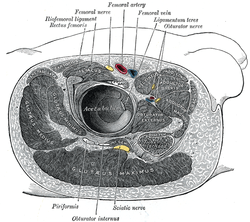Gluteus maximus muscle
| Gluteus maximus | |
|---|---|
 | |
| The gluteus maximus, with surrounding fascia. Skin covering area removed. | |
 | |
| Gluteus maximus is the most superficial muscle of the buttocks, here visible at top centre with skin removed from the entire leg | |
| Latin | Musculus glutaeus maximus |
| Gray's | p.474 |
| Origin | Gluteal surface of ilium, lumbar fascia, sacrum, sacrotuberous ligament |
| Insertion | Gluteal tuberosity of the femur and iliotibial tract |
| Artery | Superior and inferior gluteal arteries |
| Nerve | Inferior gluteal nerve (L5, S1 and S2 nerve roots) |
| Actions | External rotation and extension of the hip joint, supports the extended knee through the iliotibial tract, chief antigravity muscle in sitting and abduction of the hip |
| Antagonist | Iliacus, psoas major and psoas minor |
The gluteus maximus (also known as glutæus maximus or, collectively with the gluteus medius and minimus, the glutes) is the largest and most superficial of the three gluteal muscles. It makes up a large portion of the shape and appearance of the buttocks.
It is a narrow and thick fleshy mass of a quadrilateral shape, and forms the prominence of the nates.
Its large size is one of the most characteristic features of the muscular system in humans,[1] connected as it is with the power of maintaining the trunk in the erect posture. Other primates have much flatter buttocks.
The muscle is remarkably coarse in structure, being made up of fasciculi lying parallel with one another, and collected together into large bundles separated by fibrous septa.
Origin and insertion

It arises from the posterior gluteal line of the inner upper ilium, and the rough portion of bone including the crest, immediately above and behind it; from the posterior surface of the lower part of the sacrum and the side of the coccyx; from the aponeurosis of the erector spinae (lumbodorsal fascia), the sacrotuberous ligament, and the fascia covering the gluteus medius (gluteal aponeurosis). The fibers are directed obliquely downward and lateralward; The gluteus maximus has two insertions:
- those forming the lower and larger portion of the muscle, together with the superficial fibers of the lower portion, end in a thick tendinous lamina, which passes across the greater trochanter, and in is into the iliotibial band of the fascia lata;
- the deeper fibers of the lower portion of the muscle are inserted into the gluteal tuberosity between the vastus lateralis and adductor magnus.
Bursae
Three bursae are usually found in relation with the deep surface of this muscle:
- One of these, of large size, and generally multilocular, separates it from the greater trochanter;
- a second, often wanting, is situated on the tuberosity of the ischium;
- a third is found between the tendon of the muscle and that of the vastus lateralis.
It is also inserted on the lateral condyle of the femur.
Actions
When the gluteus maximus takes its fixed point from the pelvis, it extends the femur and brings the bent thigh into a line with the body.
Taking its fixed point from below, it acts upon the pelvis, supporting it and the trunk upon the head of the femur; this is especially obvious in standing on one leg.
Its most powerful action is to cause the body to regain the erect position after stopping, by drawing the pelvis backward, being assisted in this action by the biceps femoris (long head), semitendinosus, semimembranosus, and adductor magnus.
The gluteus maximus is a tensor of the fascia lata, and by its connection with the iliotibial band steadies the femur on the articular surfaces of the tibia during standing, when the extensor muscles are relaxed.
The lower part of the muscle also acts as an adductor and external rotator of the limb. The upper fibers act as abductors of the hip joints.
Training
- Squat (exercise)
- Lunge (exercise)
- Hip thrust exercise
- Deadlift (and variations) exercise
- Quadruped hip extensions
- Step-ups
- Four-way hip extensions
- Split Squat
- Bulgarian Split Squat (Rear Foot Elevated)
- Reverse Hyper Extension
- Glute Ham Raise
Additional images
-

Structures surrounding right hip-joint (gluteus maximus visible at bottom)
-

Innervation and blood-supply of the gluteus maximus.
-

Gluteus maximus cut showing underlying structures.
-

Gluteus maximus cut showing underlying structures.
-

Structures visible under the gluteus maximus.
-

Innervation as seen from under the gluteus maximus.
-
The gluteus medius and nearby muscles.
See also
- Table of muscles of the human body
- Coccyx (tailbone)
| Wikimedia Commons has media related to Gluteus maximus muscles. |
| Wikimedia Commons has media related to Human dissection. |
References
- ↑ Norman Eizenberg et al., General Anatomy: Principles and Applications (2008), p 17.
This article incorporates text from a public domain edition of Gray's Anatomy.
External links
- -208011185 at GPnotebook
- LUC glmx
- 13:st-0403 at the SUNY Downstate Medical Center
- Cross section at UV pelvis/pelvis-female-17
- Cross section at UV pelvis/pelvis-e12-15
- Cross section at UV pembody/body18b
- Muscles/GluteusMaximus at exrx.net
| ||||||||||||||||||||||||||||||||||||||||||||||||||||||||||||||||||||||||
